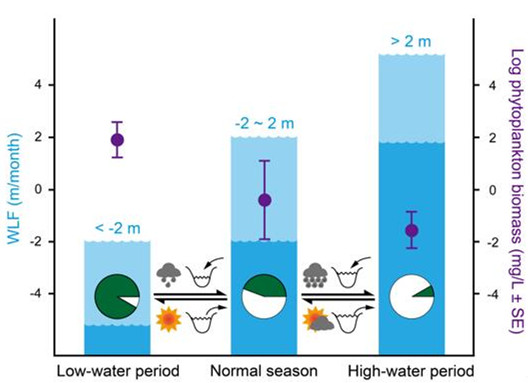
China is the largest dam-building country in the world with reserviors' total storage capacity being three times of natural lakes'. Reservoir is a highly dynamic environment. Changes in hydrological characteristics and shifts in ecosystems state may threaten biodiversity and cause large losses of sustainable ecosystem.
Phytoplankton assemblages are key components in determining ecosystem stability, and they are among the classic examples of populations undergoing switches between alternative stable states in shallow lakes. Shifts in phytoplankton community are often thought to be a result of changes in nutrient load and light regime. However, strong shifts in phytoplankton communities may be associated with hydrological changes. One of the major hydrological factors is water level fluctuations (WLF), which are controlled by both climate changes and human activities.
Previous studies have mostly focused on unraveling the mechanisms behind regime shifts in shallow lakes or exploring WLF and other environmental variables (such as nutrients and temperature) as important drivers of phytoplankton community structure in freshwater ecosystems. However, the extent to which WLF is a predictor of cyanobacteria dynamics in subtropical reservoirs is still unclear.
The Aquatic Ecohealth Group at the Institute of Urban Environment of Chinese Academy of Sciences examined effects of WLF on phytoplankton communities with emphasis on cyanobacteria dynamics in four subtropical drinking water reservoirs in southeast China. Compared with temperate reservoirs, these subtropical reservoirs were characterized by two different succession patterns of phytoplankton composition.
One pattern was dominated by cyanobacteria with high turbidity and high biomass at low negative WLF, and the other dominated by non-cyanobacterial taxa associated with clear water and low biomass at high positive WLF. WLF can influence cyanobacteria biomass directly or indirectly by influencing the light availability, nutrient loads, and other limnological parameters, therefore making it a significant though not necessarily strong predictor of cyanobacteria biomass in these reservoirs. Positive WLF (i.e. an increase in water level) can reduce the cyanobacteria biomass and dominance in complex ways.
They found that to control the risk of cyanobacterial dominance or blooms, WLF should be targeted to be above +2 m/month, which is an increase in water level of 2 m or more. Given that cyanobacterial blooms are a worldwide environmental problem, coupled with the fact that WLF is likely to be more frequent under increased artificial manipulation and more extreme climatic variability, water level management can be widely used in small and medium-sized reservoirs to prevent the toxic cyanobacterial blooms and to protect the ecosystem integrity or functions.
This study has been published in Science of the Total Environment.
The work was financially supported by the National Basic Research Program of China (2012CB956103), the National Natural Science Foundation of China (31370471 and 31500372), and the Natural Science Foundation for Distinguished Young Scholars of Fujian Province (2012J06009).

Conceptual diagram of the effect of climate change and human activity on water level fluctuations (WLF) and phytoplankton biomass (mean biomass ± SE). Light blue shading indicates uncertainty of WLF. Green pie charts represent the percentage of cyanobacteria to total phytoplankton biomass. (Image by Dr. YANG Jun’s group)

86-10-68597521 (day)
86-10-68597289 (night)

52 Sanlihe Rd., Xicheng District,
Beijing, China (100864)

